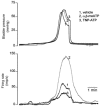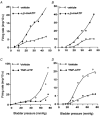Activation and sensitisation of low and high threshold afferent fibres mediated by P2X receptors in the mouse urinary bladder
- PMID: 12042363
- PMCID: PMC2290323
- DOI: 10.1113/jphysiol.2001.013469
Activation and sensitisation of low and high threshold afferent fibres mediated by P2X receptors in the mouse urinary bladder
Abstract
It has been proposed that extracellular ATP may be involved in visceral mechanosensory transduction by activating ligand-gated ion channels (P2X receptors). In this study, we have investigated the effects of the P2X(3) agonist alpha,beta-methylene ATP (alpha,beta-meATP) and antagonist 2',3'-O-trinitrophenyl-ATP (TNP-ATP) on pelvic afferents innervating the urinary bladder using an in vitro mouse bladder-pelvic nerve preparation. Intravesical application of alpha,beta-meATP (0.03-1 mM) increased multifibre discharges in a concentration-dependent manner. The agonist potentiated, whereas TNP-ATP (0.03 mM) attenuated, the multifibre responses to bladder distensions. Single-unit analysis revealed that both high threshold (HT) fibres (> 15 mmHg; known to be associated with nociception) and low threshold (LT) fibres (< 15 mmHg; probably associated with non-nociceptive events) could be induced to discharge by intravesical alpha,beta-meATP (1 mM, 0.1 ml). The response of the vast majority (21/22, 95.5 %) of HT fibres to bladder distensions was enhanced with a significantly reduced threshold and an increased peak response after exposure to the agonist. On the other hand, 59.7 % (46/77) of LT fibres showed a greater peak and a slightly reduced threshold for response to bladder distension in the presence of alpha,beta-meATP. An additional 11 'silent' fibres became mechanosensitive after exposure to alpha,beta-meATP. TNP-ATP (0.03 mM) did not affect the threshold of LT fibres, but it reduced the peak response of some (22/51, 43.1 %) LT fibres. Conversely, the antagonist resulted in a markedly elevated threshold and reduced peak activity in the majority (13/16, 81.3 %) of HT fibres. The results support the view that P2X(3) receptor-mediated mechanisms contribute to both nociceptive and non-nociceptive (physiological) mechanosensory transduction in the urinary bladder.
Figures








References
-
- Bahns E, Ernsberger U, Janig W, Nelke A. Functional characteristics of lumbar visceral afferent fibres from the urinary bladder and the urethra in the cat. Pflügers Archiv. 1986;407:510–518. - PubMed
-
- Bodin P, Burnstock G. ATP-stimulated release of ATP by human endothelial cells. Journal of Cardiovascular Pharmacology. 1996;27:872–875. - PubMed
-
- Burgard EC, Niforatos W, Biesen TV, Lynch KJ, Kage KL, Touma E, Kowaluk EA, Jarvis MF. Competitive antagonism of recombinant P2X2/3 receptors by 2′,3′-O-(2,4,6-trinitrophenyl) adenosine 5′ -triphosphate (TNP-ATP) Molecular Pharmacology. 2000;58:1502–1510. - PubMed
Publication types
MeSH terms
Substances
LinkOut - more resources
Full Text Sources
Other Literature Sources

